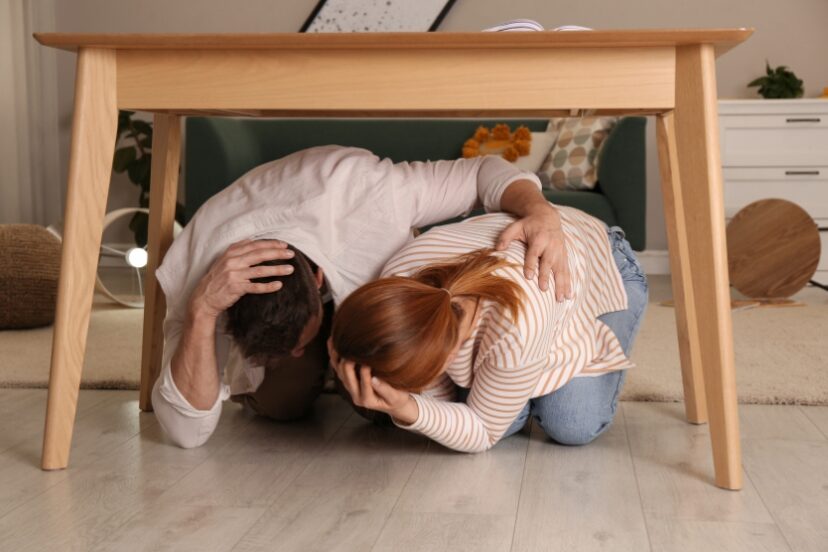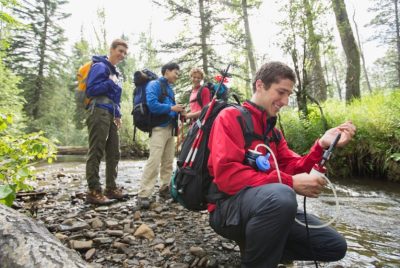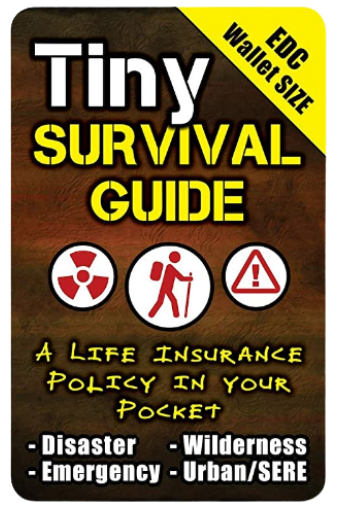Exploring the wilderness can be an exhilarating and rewarding experience, offering a chance to reconnect with…
10 Ways To Survive An Earthquake

Understanding the immense power of earthquakes underscores the importance of being prepared for such unforeseeable events.
The ground beneath can shake violently without warning, turning buildings into rubble, snapping utility lines, and drastically changing the landscape in a matter of seconds.
Though we stand powerless to stop these natural phenomena, knowledge and preparation can markedly improve our resilience and safety.
This article will arm you with practical, lifesaving strategies to not just survive but to emerge stronger in the aftermath of an earthquake.
Join me as we explore essential tips and techniques that everyone should know.
1)) Drop, Cover, and Hold On
The first and most important thing to remember during an earthquake is to drop down onto your hands and knees, take cover under a sturdy piece of furniture or against an interior wall, and hold on until the shaking stops.
This position will help protect you from falling objects and debris.
Quick Tips for Drop, Cover, and Hold On:
- Identify Safe Spots in Advance: Before an earthquake occurs, identify safe places in each room of your home, school, or workplace. A safe spot could be under a sturdy table or desk or against an interior wall away from windows and glass.
- Practice Regularly: Conduct regular earthquake drills so that the drop, cover, and hold-on action becomes second nature. Practicing will help reduce panic and increase reaction speed when an actual earthquake occurs.
- Protect Your Head and Neck: With one arm and hand, protect your head and neck, especially if you can’t get under a sturdy piece of furniture. If you’re in bed, stay there and cover your head and neck with a pillow.
The “Drop, Cover, and Hold On” technique is a fundamental safety measure during earthquakes that can significantly reduce injuries and save lives.
By identifying safe spots, practicing regularly, and knowing how to protect your head and neck, you can prepare yourself and your loved ones for the unpredictable nature of earthquakes.
Preparedness is key, and these simple steps can make a major difference in the heat of the moment.
2)) Stay Indoors
If you are indoors during an earthquake, stay inside. Do not run outside as you may be injured by falling objects or debris.
Find a safe spot away from windows, mirrors, and heavy furniture that could topple over.
Essential Tips for Staying Indoors During an Earthquake:
- Move Away from Windows: To avoid the risk of shattering glass, stay away from windows, glass doors, and exterior walls.
- Stay Under Cover: Remain under a sturdy piece of furniture to protect yourself from falling objects. If moving to cover isn’t possible, use your arms to shield your head and neck.
- Do Not Use Elevators: In case of power outages or structural damage, elevators can become traps. Use the stairs if you need to move to a different floor.
- Avoid Doorways: Once thought to be the safest place during an earthquake, doorways in modern homes are no stronger than any other part of the structure and do not provide significant protection from falling debris.
Staying indoors during an earthquake can greatly increase your safety by minimizing the risk of exterior dangers such as falling debris and shattered glass.
By moving away from windows, staying under durable furniture, avoiding elevators, and forgoing the misconception of doorways as safe havens, individuals can protect themselves from some of the most common injuries associated with earthquakes.
Adhering to these essential tips ensures that you are better prepared to stay safe until the shaking stops.
Preparedness within the home is crucial, as it provides the foundation for survival in these sudden and unpredictable events.
3)) Secure Heavy Items
Make sure to secure heavy items such as bookshelves, water heaters, and electronics to prevent them from falling during an earthquake.
Use brackets or straps to secure these items to the wall or floor.
Examples of Securing Heavy Items:
- Bookshelves and Cabinets: Anchor these to wall studs using L-brackets, straps, or anchors designed for this purpose to prevent tipping.
- Televisions and Computer Monitors: Secure your TVs and monitors with straps anchored to the wall or the furniture they sit on to keep them from falling.
- Water Heaters and Appliances: Use flexible straps to secure water heaters and large appliances to wall studs to prevent movement and potential water and gas leaks.
- Heavy Artwork and Mirrors: Hang heavy items with closed hooks or anchors that ensure they stay on the wall and don’t become airborne hazards.
- Tall, Heavy Furniture: Secure tall, heavy pieces of furniture such as dressers, wardrobes, and bookcases to wall studs using furniture anchors to prevent them from toppling over.
Securing heavy items within your home or workplace is a proactive step towards earthquake safety that cannot be overlooked.
By anchoring bookshelves, appliances, electronics, and decorative items, you significantly reduce the risk of injury from falling or flying objects during an earthquake.
This measure not only helps in minimizing potential physical harm but also contributes to preserving your property.
The stability of your environment during an earthquake can make a critical difference in safety, making these precautions invaluable in earthquake-prone areas.
4)) Have an Emergency Kit
It is essential to have an emergency kit prepared in case of an earthquake. Your kit should include items such as water, non-perishable food, a flashlight with extra batteries, a first aid kit, medications, a whistle for signaling for help, and important documents.
Earthquake Emergency Kit Checklist:
- Water: At least one gallon per person per day for at least three days, for drinking and sanitation.
- Non-Perishable Food: A minimum three-day supply per person of ready-to-eat foods.
- Flashlight: With extra batteries ensure you have a light source if the power goes out.
- First Aid Kit: Complete with bandages, antiseptic wipes, pain relievers, and any necessary prescription medications.
- Battery-Powered or Hand Crank Radio: To stay informed about news and emergency information.
- Whistle: To signal for help if needed.
- Dust Masks: To help filter contaminated air and plastic sheeting and duct tape to shelter-in-place.
- Moist Towelettes, Garbage Bags, and Plastic Ties: For personal sanitation.
- Wrench or Pliers: To turn off utilities if necessary.
- Local Maps: To help with navigation if electronic devices fail.
- Cell Phone with Chargers and a Backup Battery: To ensure communication with family members and emergency services.
- Important Documents: Copies of insurance policies, identification, and bank account records in a waterproof, portable container.
- Cash: In case ATMs and credit card machines are not operational.
Having an emergency kit ready is an essential part of earthquake preparedness.
This kit serves as your lifeline during and immediately after an earthquake, providing critical supplies such as water, food, first aid, and means of communication and shelter.
By assembling all the recommended items, you ensure that you and your family can sustain yourselves in the aftermath of an earthquake, even if basic services are disrupted or unavailable.
The key to surviving natural disasters lies not only in the immediate response but also in the meticulous preparation beforehand.
5)) Develop a Family Emergency Plan
Sit down with your family members and create a plan for what to do in case of an earthquake.
Designate meeting spots both inside and outside of your home and establish communication methods in case you are separated during the disaster.
Tips for Developing a Family Emergency Plan:
- Discuss Specific Needs: Take into account the special needs of each family member, including pets, when developing your plan.
- Identify Safe Spots in Your Home: Educate everyone about safe places in the home for cover during an earthquake, like under sturdy furniture or against an interior wall, away from windows and heavy objects.
- Establish Meeting Places: Determine a safe spot outside your home and a secondary location outside your neighborhood in case you can’t return home or are evacuated.
- Create a Communication Strategy: Decide how you will contact each other if separated. Consider a family group chat, an out-of-area emergency contact, or social media check-ins.
- Practice Drills: Regularly conduct earthquake drills at home so every family member knows what to do if an earthquake occurs.
- Document and Share the Plan: Make sure the plan is written down, copies are given to all family members, and everyone understands their roles and responsibilities.
- Review and Update Regularly: Revisit the plan periodically and update it as needed to reflect any changes in your family situation, contact information, or local emergency procedures.
Developing a comprehensive family emergency plan is a critical step in ensuring the safety and preparedness of your loved ones during an earthquake.
It fosters a sense of security and readiness, allowing each family member to know exactly how to act, where to go, and how to communicate when disaster strikes.
By considering the unique needs of each family member, establishing clear meeting points, and practicing the plan regularly, you lay the groundwork for a cohesive and effective response to earthquakes.
The strength of your plan lies in its clarity, its adaptability to various scenarios, and the regularity with which it is reviewed and practiced.
6)) Know How To Shut Off Utilities
In the event of a major earthquake that causes gas leaks or other utility issues, it is crucial to know how to shut off your gas, electricity, and water supply.
Make sure all family members know how to do this safely.
Tips for Shutting Off Utilities:
- Locate Your Utility Shut-off Valves: Familiarize yourself with the location of gas, water, and electricity shut-off valves in your house. Ensure clear access to these valves without obstructions.
- Learn the Shut-off Procedures: Understand the proper procedures for turning off your utilities. For gas, this usually requires a wrench to turn the valve a quarter turn. For water and electricity, know which lever or breaker to switch.
- Keep Necessary Tools Handy: Store a wrench or other necessary tools near the gas valve or somewhere easily accessible. Ensure all family members know where these tools are kept and how to use them properly.
Knowing how to safely shut off utilities is a fundamental aspect of earthquake preparedness.
This knowledge can prevent further damage to your home and safeguard your family from potential hazards like gas leaks, water damage, and electrical fires following an earthquake.
Ensuring that every member of your household understands where the shut-off valves are located and how to operate them empowers your family to react swiftly and safely in the critical moments following a disaster.
Regularly reviewing and practicing these procedures ensures that in times of emergency, your response will be second nature.
7)) Be Mindful of Aftershocks
After the initial earthquake hits, there may be aftershocks that follow. Be prepared for these smaller tremors by staying alert and ready to take cover if necessary.
Examples to Help Be Mindful of Aftershocks:
- Create Safe Zones in Each Room: Identify and prepare safe spaces in every part of your home where you can quickly take cover during aftershocks. These could be under sturdy tables or desks away from windows.
- Keep Emergency Supplies in Multiple Locations: In addition to your main emergency kit, have smaller emergency packs with essentials like water, snacks, a flashlight, and a whistle in different parts of your home and car.
- Stay Informed Through Alerts: Use a battery-powered or hand-crank radio to stay updated with the latest news and information from local authorities about possible aftershocks and safety instructions.
Being mindful of aftershocks is crucial to maintaining safety and minimizing risk in the aftermath of an earthquake.
Aftershocks, although typically smaller than the main shock, can still cause significant damage and injuries, especially to structures already weakened.
By preparing safe zones, keeping emergency supplies readily accessible throughout your home and vehicle, and staying informed on current conditions and safety recommendations, you equip yourself and your loved ones with the knowledge and tools needed to respond effectively.
This proactive approach helps ensure that, should aftershocks occur, you are prepared to protect yourself and those around you.
8)) Stay Informed
Keep yourself informed about the situation by listening to local news reports on a battery-powered radio or smartphone with emergency alerts enabled.
Follow instructions from authorities regarding evacuation orders or safety tips.
Tips to Stay Informed During an Earthquake:
- Sign Up for Emergency Alerts: Register for local emergency notification systems to receive real-time alerts and updates during a disaster.
- Download Reliable News Apps: Install apps from reputable news outlets and ensure notifications are enabled to get the latest information.
- Use a NOAA Weather Radio: Keep a battery-powered or hand-crank NOAA (National Oceanic and Atmospheric Administration) weather radio to get updates directly from the authorities.
- Follow Trusted Social Media Accounts: Identify and follow the social media accounts of local government agencies, emergency services, and meteorological departments for timely updates.
- Check on Neighbors and Share Information: Maintain communication with your neighbors to share updates and verify information, ensuring that everyone has access to accurate and current news.
Remaining informed throughout an earthquake is pivotal in keeping oneself and loved ones safe.
By leveraging technology and community networks to receive accurate and timely information, individuals can make informed decisions, adhere to the guidance of local authorities, and effectively manage the situation.
Whether it’s through emergency alerts, news apps, weather radios, or social media, staying updated ensures that you are well-prepared for any developments.
Sharing this crucial information with neighbors further strengthens community resilience, ensuring that everyone is equipped to face emergencies together.
9)) Check on Neighbors
After ensuring your safety during an earthquake, check on your neighbors to see if they need assistance or medical attention. Offer help where possible while also keeping yourself safe.
Tips for Checking on Neighbors After an Earthquake:
- Assess Your Safety First: Ensure it’s safe to leave your home before checking on neighbors.
- Wear Protective Gear: Put on sturdy shoes and protective clothing to avoid injury from debris or broken glass.
- Bring Your Mobile Phone: Take your mobile phone with you to call for emergency help if needed.
- Offer Practical Assistance: Ask if they need specific help, such as medical assistance, contacting family members, or temporary shelter.
- Stay Aware of Aftershocks: Be prepared to move to safety quickly if aftershocks occur while you’re checking on neighbors.
Checking on neighbors after an earthquake not only fosters a sense of community but also ensures that those who are vulnerable or unable to seek help receive the support they need.
By assessing your safety first, wearing the appropriate protective gear, and being mindful of ongoing dangers such as aftershocks, you can offer valuable assistance while minimizing risks to your well-being.
Whether it’s providing medical aid, helping with communications, or offering comfort in times of distress, these acts of solidarity are crucial in the immediate aftermath of a disaster, reinforcing resilience and mutual support within communities.
Pro-Tip: Investing in high-quality protective footwear is an essential yet often overlooked aspect of earthquake preparedness.
During and after an earthquake, the ground and surrounding structures can become littered with debris, broken glass, and sharp objects.
High-quality protective footwear, designed to withstand harsh conditions, can significantly reduce the risk of foot injuries, enabling you to move safely across compromised areas.
These shoes are not only durable but also offer better grip and support, which are crucial for navigating through rubble and unstable surfaces during rescue efforts or when evacuating.
By opting for sturdy, protective footwear, you are taking a proactive step toward personal safety in the unpredictability of earthquake scenarios.
10)) Practice Regular Drills
Just like fire drills in schools or workplaces help people prepare for emergencies, practicing earthquake drills at home can make a significant difference in how well you respond when disaster strikes.
Tips for Practicing Regular Earthquake Drills:
- Schedule Drills Regularly: Set a routine schedule for earthquake drills at home, ensuring that all family members can participate.
- Designate Safe Spots: Identify and communicate the safest places in each room to take cover during an earthquake such as under sturdy furniture or against an interior wall.
- Practice Drop, Cover, and Hold On: Drill the “Drop, Cover, and Hold On” method with everyone in the household to minimize injuries during an earthquake.
- Simulate Real-Life Scenarios: Use a timer to add urgency and simulate the suddenness of an earthquake, making the drill more realistic.
- Review and Improve Your Plan: After each drill, review what went well and what could be improved, then adjust your emergency plans accordingly.
Practicing regular earthquake drills is a critical step in ensuring that everyone in your household knows how to react swiftly and safely when the ground shakes.
By turning preparedness into a routine, you not only foster a sense of calm and control during an actual emergency but also significantly reduce the risk of injuries.
These drills empower each family member, from the youngest to the oldest, with the knowledge and confidence to protect themselves.
As you continue to refine your response through simulation and review, you strengthen your home’s resilience against earthquakes, ensuring that when seconds count, your family is ready to act decisively.
Conclusion
Surviving an earthquake demands preparation, awareness, and the ability to remain calm under pressure.
By following the 10 tips outlined in this article, you can significantly enhance your safety and the safety of those around you.
Earthquakes do not give warnings, but knowledge and preparation can serve as your alert system.
Regularly update your emergency kit, review your family’s emergency plan, and practice drills to ensure that everyone knows how to respond effectively.
In the wake of an earthquake, resilience is key; by staying informed, helping neighbors, and following local advisories, communities can rebuild and recover stronger than before.
Empower yourself today with these survival strategies to face tomorrow’s uncertainties with confidence.





